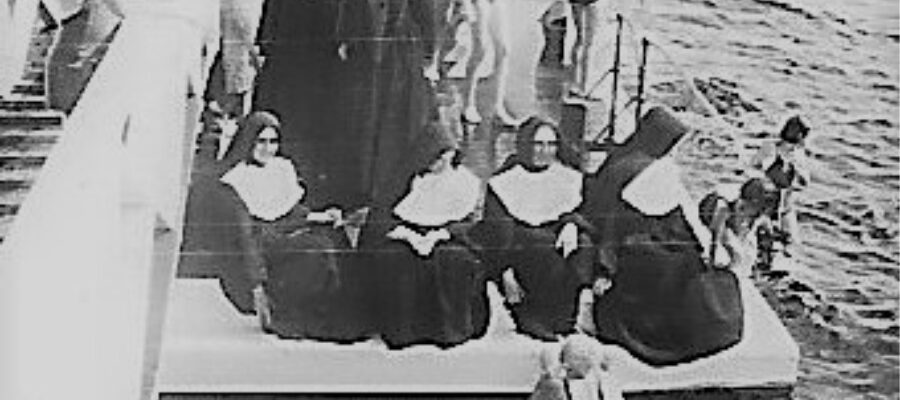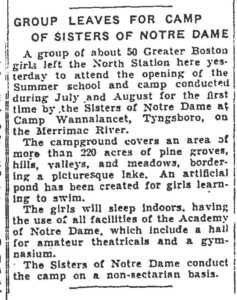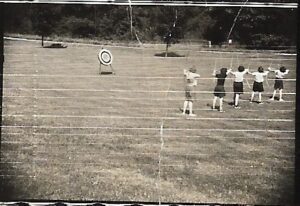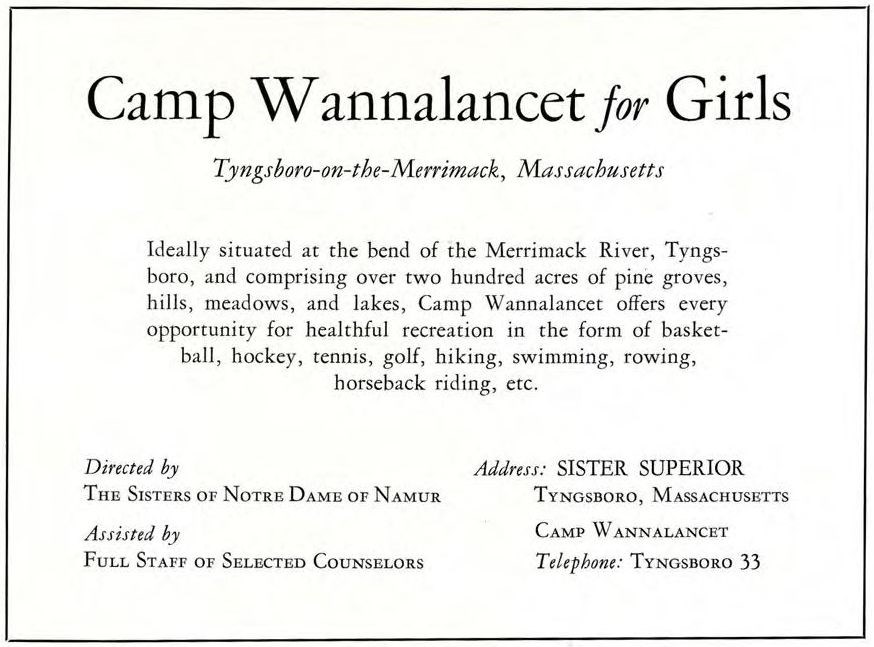
Sisters of Notre Dame de Namur on the pier with some of the campers at Camp Wannalancet in Tyngsboro c. 1935
In 1908, the Sisters of Notre Dame bought land in Tyngsboro. The property had once belonged to the Tyng family, for which Tyngsboro was named. At the time of the sale, the estate was owned by stage actress Nance O'Neill. Financial difficulties forced her to sell and the Sisters of Notre Dame were eager to buy the land. For the next twenty years, the grounds, which included 220 acres of meadows, hills, ponds and the Nance O'Neill estate, were used to host picnics for many of the Notre Dame students. It also served as a place of rest and relaxation for the Sisters of Notre Dame de Namur and other women's religious congregations. Though the original purpose of the purchase had been to provide a retreat for the sisters, from the beginning they hoped to build an Academy on the grounds.
In 1927, their dreams were fulfilled when the Academy of Notre Dame at last opened. But the opening did not change the original purpose of the property—to provide a refuge for weary sisters. The land continued to offer sisters a place of rest during the summer. Six years later, however, in July of 1933, the sisters recognized the beauty of the surroundings and expanded their mission by opening a summer camp for children. They named it Camp Wannalancet, after a Native American chief living in the Lowell area between 1619 and 1686. After being betrayed by the white settlers, he took his people to Canada where he died in 1697.

Before they opened the camp that first summer, though, the sisters encountered some resistance from neighbors. The Tewksbury Annalist wrote that in an attempt to prevent the camp from opening, they [the neighbors] "tried to stop the supply flow of water into the pond. If they had been successful, the camp no doubt would have been a failure." Though the Annalist doesn't indicate which pond the neighbors tried to affect, it was most likely Uptons Pond, which is fed from the Merrimack River by a channel under Middlesex Rd. The Superior at Tewksbury, Sr. Agnes Cecilia Loughlin turned to her brother-in-law for help. He was William Flaherty, a prominent Boston attorney. With his assistance, they were able to keep the water flowing, as it were, and the camp opened on Saturday, July 1, 1933. That first camp season, the sisters had fifty children enrolled. Sisters assigned the duty of overseeing the children arrived on June 20th to prepare for the arrival of the first campers.
The Boston Globe reported on the opening. "The camp covers more than 220 acres of pine groves, hills, valleys, and meadows, bordering a picturesque lake. There is also an artificial pond for girls learning to swim. . .Gardeners, foresters and road builders have converted the property into a veritable fairyland. There are groves, bridle paths, tennis courts and other recreational facilities for girls ranging from 5 to 20 years of age."
Among the many activities offered through the years were swimming, horseback riding, basketball, hockey, tennis, golf, hiking, swimming, archery, as well as the opportunity to participate in theatrical productions. The enrollment fluctuated during those first years, mostly due to the Depression. While the sisters began with fifty campers in 1933, two years later, in 1935, they only had twenty campers apply to attend at the beginning of the season.

To provide the best possible counselors in an attempt to raise enrollment, the sisters turned to Emmanuel College students. In 1934, the Boston Globe reported that five Emmanuel College students had been hired to teach swimming, archery and horseback riding. With the college students providing the necessary support to the camp, the enrollment for campers slowly began to grow with every passing year. By 1942, there were 170 children attending Camp Wannalancet. The next year there were 335 children at the camp.
In 1949, the sisters wrote that the "camp is now an organized affair and each year repeats itself, the children are happy and glad to return each year." Despite the success of the camp, the sisters made the decision to close it in 1951, due to the rising need of sisters attending summer school. That year, over 100 sisters went to Tyngsboro for those classes. The camp remained closed for the next fourteen years.

In 1965, the Tyngsboro Annalist wrote that, "earlier in the year Sister Provincial had told us that she wished to have a Day Camp at Tyngsboro. With the close of school, preparations were immediately begun for the opening of Camp Wannalancet. . . Sisters spent the week following the closing of school in clearing the lake area that was to be used for swimming, spreading sand on the beach, fixing up the long neglected bath houses, getting ready the arts and crafts projects, and in general doing all they could to make the camp a success." The camp opened under the direction of Sr. Winifred Hall (1920-2006). That summer they had fifty children attend. The camp opened again in 1967 and in 1968, but that year the Annalist reported that, "On July 8 the camp opened, but the numbers were small. It does not seem that a larger number cam be expected unless considerable expenditures are made relative to available facilities. Transportation problems, too, are a difficulty for many who would like to come." Unable to draw in more campers or make the necessary repairs, Camp Wannalancet closed at the end of the 1968 season.
Did you attend Camp Wannalancet? If yes, share your memories by leaving a comment!
This article was written by Nancy Barthelemy, Archivist for Sisters of Notre Dame de Namur U.S. East-West Province / East.
Sources consulted for this article
Notre Dame Academy, Tyngsboro Annals, 1934-1972. 2017.26.
Boston Globe Archives, 1872-2018.

I did attend Camp Wannalancet in 1965 . . . as a counselor. I recall tying more sneakers that summer than I thought possible, having been assigned to the little ones, among them Mary Elizabeth Sweeney and Sue Ellen Greene. Sr Justina St John was the superior, Sr Helen Emmanuel was about recuperating from surgery, and the loveliest nun whose name I can't recall–Euphrasia? was active in the camp. One day when I took my charges for their afternoon swim in the lake, a snake surfaced and swam about them. The swim instructor quickly said, "Shhhhh! We don't want to scare him!" I also used to take my charges out on the lake in a rowboat, and once a ways from the dock, would tell them if they wanted to return to sing "I Dream of Jeannie with the Big Brown Eyes." The lake had a lot of lily pads.
What wonderful memories, Jeanne! Thanks for sharing them with us!
Rachael
(For the Sisters)